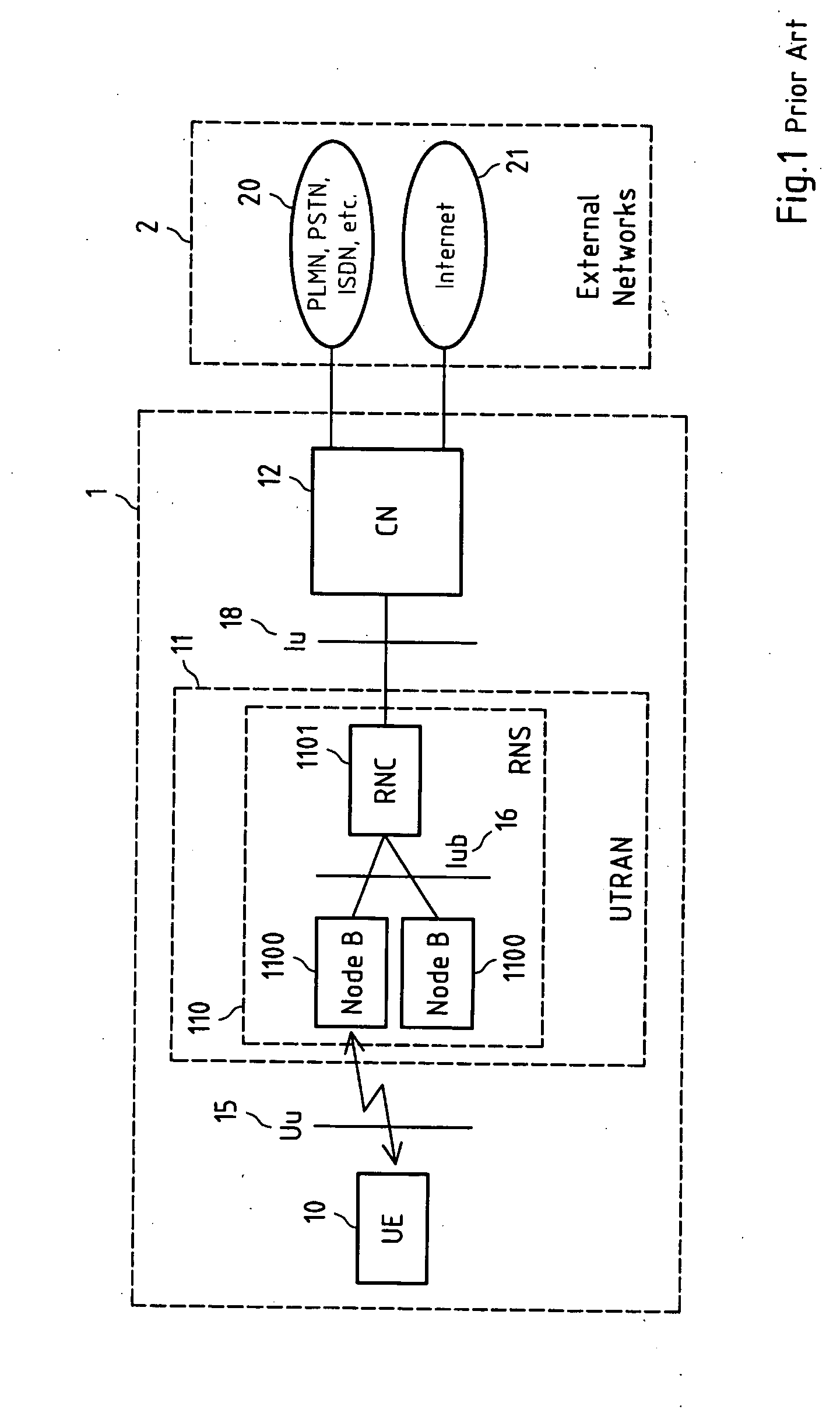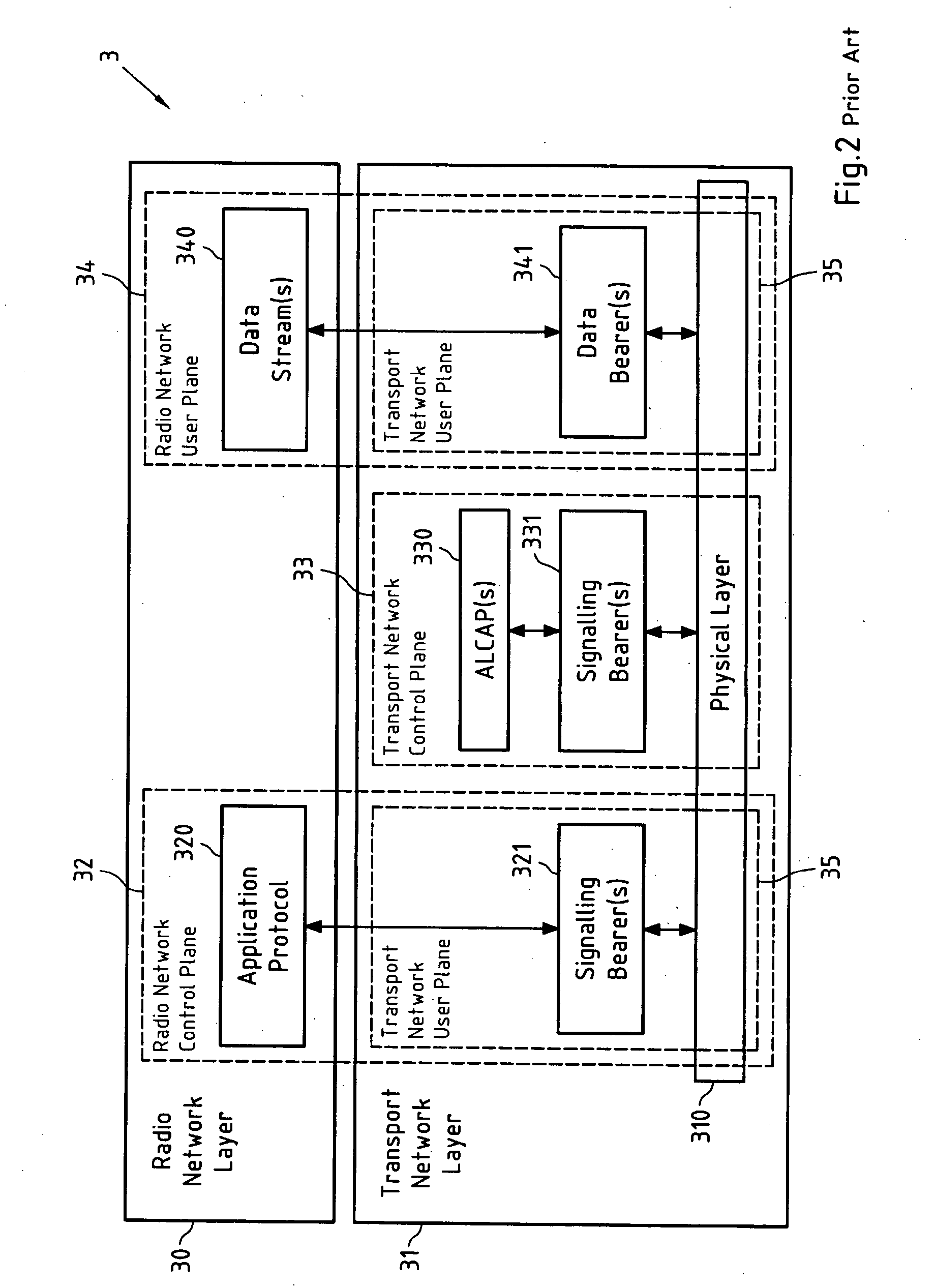Deployment of different physical layer protocols in a radio access network
a radio access network and physical layer technology, applied in the field of different physical layer protocols in the radio access network, can solve the problems of increasing management complexity, increasing management complexity, and potential incompatibility
- Summary
- Abstract
- Description
- Claims
- Application Information
AI Technical Summary
Benefits of technology
Problems solved by technology
Method used
Image
Examples
first embodiment
[0133]FIG. 5a depicts a first exemplary user plane protocol architecture 50 for the transmission of data streams 340 (see FIG. 2) over data (or transport) bearers 341 in the user plane 34 of a UTRAN according to the first embodiment of the present invention. Therein, said data streams 340 contain data from applications running on the top-most layer of the protocol architecture, for instance speech, and consist of a plurality of Frame Protocol (FP) frames. The data streams are transmitted between a base station (for instance the base station 42-1 of FIG. 4) and an RNC (for instance the RNC 40 of FIG. 4) via a base station hub (for instance the base station hub 41 of FIG. 4).
[0134] According to the first embodiment of the present invention, the ATM protocol 50-2 operated between the RNC and the base station for the transmission of user plane data streams 340 is not terminated in the base station hub. The FP frames are converted into ATM cells by the AAL2 protocol layers, i.e. AAL2 SS...
second embodiment
[0143]FIG. 6a depicts a user plane protocol architecture 60 for the transmission of data streams 340 (see FIG. 2) over data (or transport) bearers 341 in the user plane 34 of a UTRAN according to the second embodiment of the present invention. Therein, it is readily seen that the AAL2 CPS protocol 60-4 operated between the RNC and the base station is not terminated by the base station hub, so that AAL2 CPS packets are transmitted over the Ethernet network. This can be achieved with a transport layer 60-2 above the IEEE 802.3 MAC layer 60-1, which may for instance be implemented by using a proprietary header or even IP / UDP.
[0144] In the base station hub, this transport layer is then interworked with the ATM layer 60-3 used on top of the PDH / SDH physical layer protocol 47 operated between the RNC and the base station hub (see the left side of the protocol architecture 60). This may be achieved by a mapping table, which maps ATM interface parameters, VPIs, VCIs and CIDs into MAC addre...
third embodiment
[0158]FIG. 7a depicts a user plane protocol architecture 70 for the transmission of data streams 340 (see FIG. 2) over data (or transport) bearers 341 in the user plane 34 of a UTRAN according to the third embodiment of the present invention. In this user plane protocol architecture 70, the FP protocol 70-7 operated between the RNC and the base station is not terminated by the base station hub.
[0159] According to this third embodiment of the present invention, the FP frames can be transported on top of a proprietary multiplexing layer that interfaces with the IEEE 802.3 MAC layer 70-1 residing on top of an IEEE 802.3 physical layer protocol 46, or can be transported on top of a UDP / IP protocol architecture 70-2, 70-3, as it is depicted in FIG. 7a. The base station hub then terminates the UDP layer 70-3 towards the base station and the AAL2 SSSAR layer 70-6 towards the RNC. Therein, the AAL2 SSSAR layer 70-6 resides on top of the AAL2 CPS layer 70-5, which in turn resides on top of ...
PUM
 Login to View More
Login to View More Abstract
Description
Claims
Application Information
 Login to View More
Login to View More - R&D
- Intellectual Property
- Life Sciences
- Materials
- Tech Scout
- Unparalleled Data Quality
- Higher Quality Content
- 60% Fewer Hallucinations
Browse by: Latest US Patents, China's latest patents, Technical Efficacy Thesaurus, Application Domain, Technology Topic, Popular Technical Reports.
© 2025 PatSnap. All rights reserved.Legal|Privacy policy|Modern Slavery Act Transparency Statement|Sitemap|About US| Contact US: help@patsnap.com



